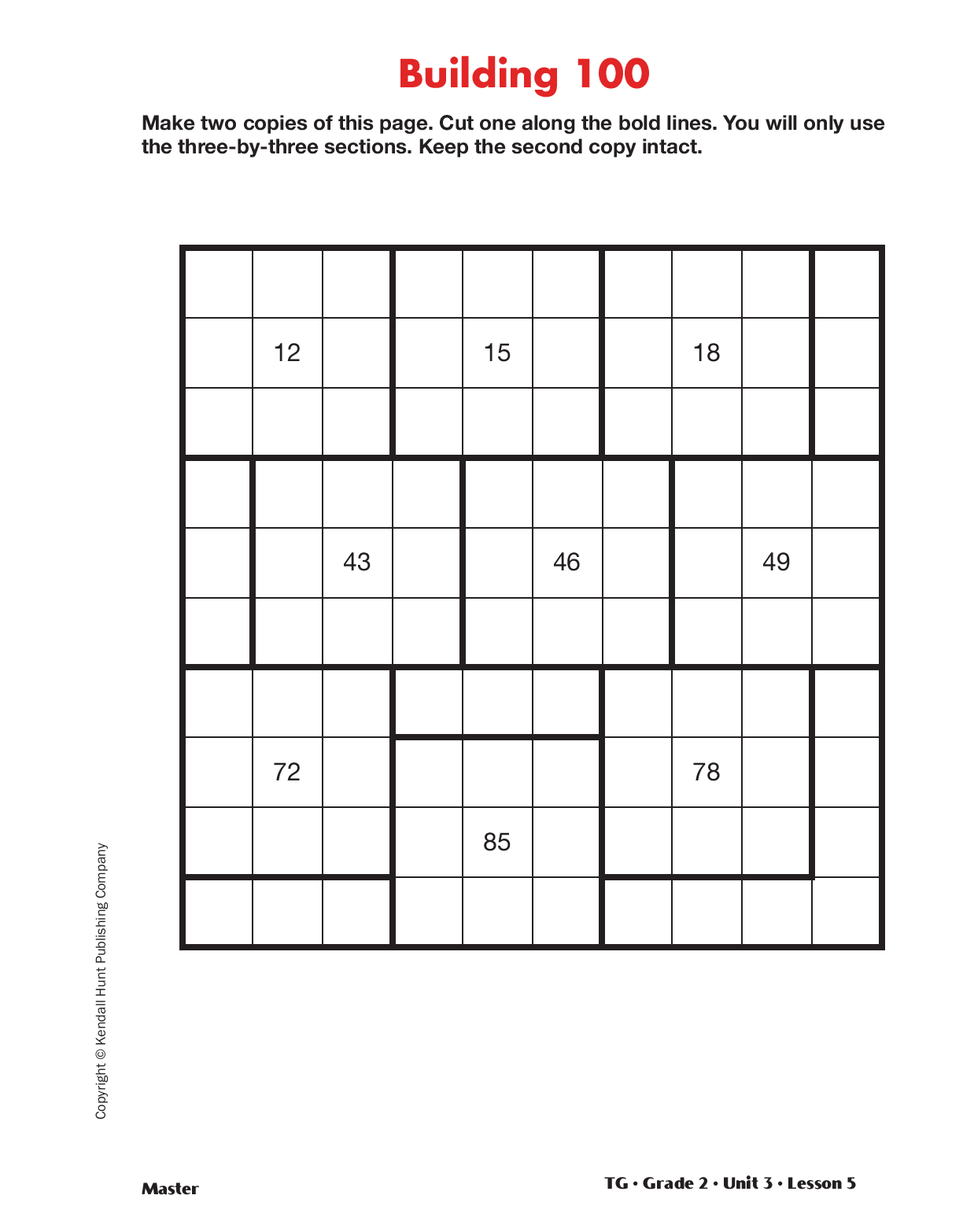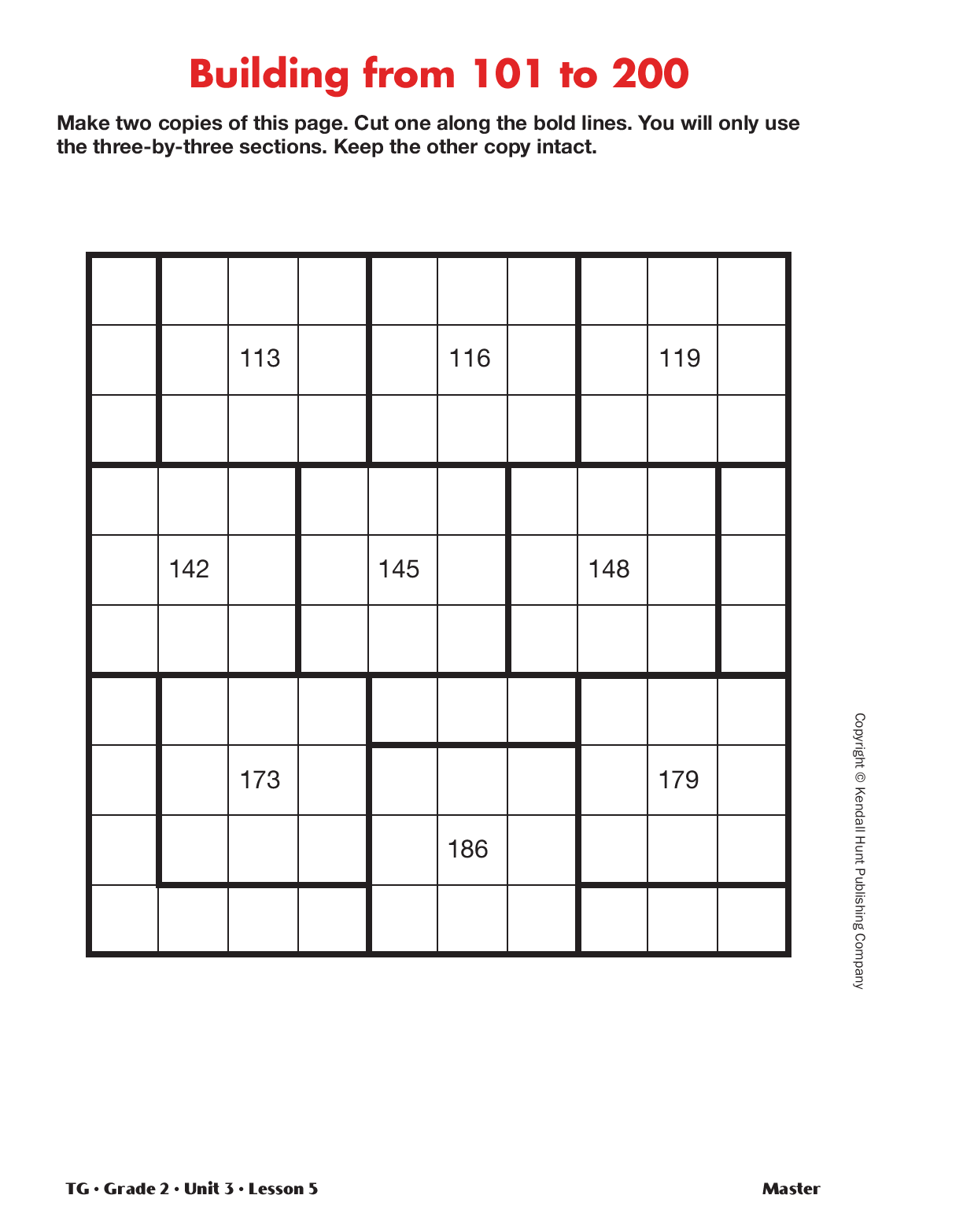Build to 200.
The Building 100 and
Building from 101 to 200
Masters break up the 200 Chart into two parts:
the numbers 1 through 100 and the numbers 101
through 200. Show the display of the 200 Chart.
Explain to the class that you cut a 200 Chart into sections.
See Materials Preparation. Scatter a few of the
prepared cut-up sections on a display to illustrate the
problem. Student groups will fill in the eight missing
numbers within one three-by-three section. Then the
class will put the sections together to build a new 200
Chart.
The 200 Chart is a tool that some students will use regularly.
It should always be available to them during class and when
they work on the Daily Practice and Problems. A 200 Chart is
available in the Student Activity Book Reference section.
To demonstrate, complete one or two sections from
each of the two Masters. Encourage students to start
by deciding what goes to the right and to the left of the
given number.
For example, if you are working on the section with 46, ask:
- What number goes to the right of 46? What number
goes to the left of 46? (The number to the right of
46 should be 47. The number to the left of 46 is
45.)
- How did you decide? (You add one when you go to
the right. You subtract one when you go to the left.)
Remind students of the patterns discussed previously.
Then proceed to the row beneath 46.
- Should the numbers in the row below 46 be more
than 46 or less than 46? (The numbers below 46 are
more than 46.)
- What number do we add or subtract to land directly
below a number? (We add ten to land directly
below a number.)
- What number do we land on after we add ten to 46?
(We land on 56.)
- Should the numbers above 46 be more or less than
46? (less than 46)
- What number do we subtract to land directly above a
number? (ten)
- What number do we land on after we subtract
10
from 46? (36)
- What number do we land on after we subtract
10
from 45? (35)
- What number do we land on after we add 10 to 47? (57)
- What numbers should be written in the blank boxes? (top row: 37, bottom row: 55)
If students need more whole class work to fill in a
square section, work on another square section.
Distribute one or two of the remaining sections to
small group of students. Have them work together to
fill in the rest of the numbers. All group members
should be able to explain how they filled in the section.
A member from each group can then come to the
display and fill in the puzzle by placing their piece
over the display Building 100 Master or
Building from 101 to 200 Master. Ask students to explain how they
filled in the numbers. The class can fill in the remaining
blanks together.
Work with Intervals on the 200 Chart.
Point to a
number, such as 36, and ask questions similar to the
ones that follow:
- What number comes before 36? (35)
- What number comes after 36? (37)
- The number 36 is in the row that starts with what number? (31)
- The number 36 is in the row that ends with what number? (40)
- Name a number that is between 31 and 40. (32, 33, 34, 35, 36, 37, 38, 39)
- Name a number that is in the row above 36. (Possible response: 24)
- Name a number in the row below 36. (Possible response: 47)
Write 31–40 on the board. Explain that when we write
31–40, we include all the numbers between 31 and
40, including 31 and 40. We call this an interval.
- Name a number in the interval 31–40. (Possible
response: 32)
- Is 36 in the interval between 38 and 42? Explain your
reasoning. (No, the only numbers in that interval
are 38, 39, 40, 41 and 42.)
- Is 36 in the interval 35–45? Why? (Yes. Because 36
is just one more than 35.)
- Is 36 in the interval 20–40? Why? (Yes; Possible
response: You can see it on the 200 Chart. It is
between 20 and 40.)
- I’m thinking of a number between 30 and 40. It is
closer to 40. The number is 3 more than 35. What is
the number? (38)
- Name a number in the interval 121–130. (Possible
response: 125)
- Is 156 in the interval between 158 and 162? Explain
your reasoning. (No, the only numbers in that interval
are 158, 159, 160, 161 and 162.)
- Is 172 in the interval 171–180? Why? (Yes. Because
172 is just one more than 171.)















